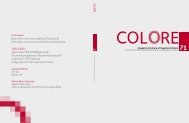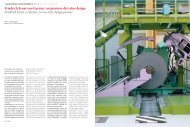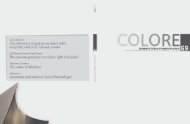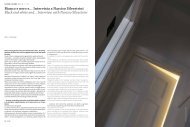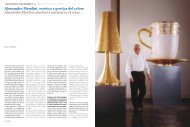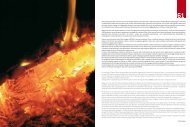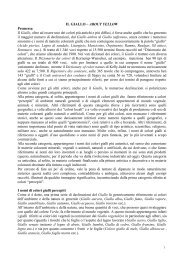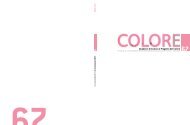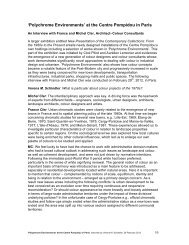Quaderni di Cultura e Progetto del Colore - Istituto Del Colore
Quaderni di Cultura e Progetto del Colore - Istituto Del Colore
Quaderni di Cultura e Progetto del Colore - Istituto Del Colore
Create successful ePaper yourself
Turn your PDF publications into a flip-book with our unique Google optimized e-Paper software.
CULTURA / CULTURE [ 1 2 (3 + 4) 5 6 7 8 9 ]<br />
ne fanno sentire la loro voce:<br />
- I fattori importanti sono il livello luminoso ed il<br />
contrasto, sia acromatico, sia cromatico<br />
- Il marrone altro non è che un arancio scuro ( o<br />
anche un giallo scuro) , cioè, con bassa luminanza<br />
- n alcuni casi per vedere un marrone, dobbiamo<br />
presentarlo circondato da uni sfondo <strong>di</strong> luminanza<br />
molto maggiore, per creare un opportuno effetto<br />
<strong>di</strong> contrasto simultaneo (questo fatto fu portato<br />
alla conoscenza <strong>del</strong> pubblico quando la televisione<br />
commerciale passò dal bianco e nero al colore)<br />
2.1 La riproduzione <strong>del</strong>le immagini<br />
La scelta <strong>del</strong>la illuminazione e <strong>del</strong> contrasto in fotografia,<br />
in televisione, nelle immagini <strong>di</strong>gitali è stata<br />
ed è uno dei principali problemi. Oggi si è sempre<br />
più esigenti per quanto riguarda la qualità <strong>del</strong>l’immagine,<br />
la preferenza <strong>del</strong>l’osservatore e la lettura<br />
<strong>di</strong> un messaggio trasmesso , appunto tramite immagini.<br />
Da un lato, la variabilità <strong>del</strong> livello <strong>di</strong> illuminazione<br />
e <strong>del</strong>la composizione spettrale ambientali<br />
naturali, dall’altro la complessità <strong>del</strong>le scene che<br />
si devono riprodurre e trasmettere (per esempio, la<br />
coesistenza fra la presenza <strong>di</strong> un in<strong>di</strong>viduo, con il<br />
colore <strong>del</strong>la sua pelle, <strong>di</strong> fogli, <strong>di</strong> superfici metalliche,<br />
<strong>di</strong> altre sorgente, ecc., con le loro <strong>di</strong>verse esigenze<br />
foto-colorimetriche, richiedono una preparazione<br />
altamente specializzata dei corrispondenti<br />
operatori <strong>del</strong> settore <strong>del</strong>la ripresa e <strong>del</strong>la riproduzione.<br />
Un caso particolare è quello <strong>di</strong> libri de<strong>di</strong>cati<br />
alle arti visive, dove il pubblico è sempre più esigente,<br />
la qualità e la fe<strong>del</strong>tà deve essere sempre<br />
all’altezza <strong>del</strong>la situazione ed il prezzo <strong>del</strong>l’opera<br />
deve, ovviamente, essere accessibile.<br />
Anche dal punto <strong>di</strong> vista <strong>del</strong>l’Ingegneria <strong>del</strong>l’illuminazione<br />
la situazione non è semplice. Per esempio,<br />
per quanto riguarda l’illuminazione nei musei,<br />
time of the transition from white-and-black TV to<br />
color TV, where high illuminations were mandatory<br />
to record the images to be transmitted.<br />
2.1 Image reproduction<br />
The selection of the proper illumination con<strong>di</strong>tions<br />
and the contrasts are one of the major problems<br />
in Photography, TV and Digital Imaging. Nowadays<br />
people are increasingly deman<strong>di</strong>ng about the quality<br />
of images, their preferences and the con<strong>di</strong>tions<br />
of easily “rea<strong>di</strong>ng” and capturing the information<br />
<strong>di</strong>splayed as images. A high degree of skill and<br />
qualification is required, because of the outdoor<br />
variabiliy of lighting and spectral composition,<br />
and because of the complexity of the scenes. For<br />
instance, sometimes metal surfaces coexist with<br />
the faces of people of <strong>di</strong>fferent races, with light<br />
sources, etc. A particular case is represented by<br />
the books containing images of paintings and visusal<br />
arts in general, where a high photo-colorimetric<br />
fi<strong>del</strong>ity is mandatory, and the cost should be<br />
accessibile,<br />
The situation is other-than-simple also from the<br />
stand point of Lighting Engineering. For instance,<br />
the availabilty of new sources imposes peculiar<br />
considerations in the case of Museum and Art Gallery<br />
lighting, where all the colors, inclu<strong>di</strong>ng brown,<br />
are <strong>di</strong>splayed. Among other things, it should not be<br />
forgotten that some paintings had been ordered to<br />
be lit by candles.<br />
1.2 Color appearance<br />
This central issue of Visual Science, although per sé<br />
not new, is a matter of advanced vsual research..<br />
Even if in the tra<strong>di</strong>tional text books those experiments<br />
are reported where spectral stimuli were<br />
used (hence, by omitting brown), in the second<br />
si devono prendere decisioni ogni volta che vengono<br />
immesse sul mercato nuove sorgenti. Va tenuto<br />
presente che tutti i colori, marrone incluso, sono<br />
presenti nelle pitture <strong>di</strong> tutti i tempi, senza <strong>di</strong>menticare<br />
che in molti casi quelle pitture erano state fatte<br />
per l’illuminazione <strong>del</strong>le can<strong>del</strong>e.<br />
2.2 L’aspetto dei colori (color appearance)<br />
Questo tema chiave nella Scienza Visione è oggi affrontato<br />
nel quadro <strong>del</strong>la ricerca <strong>di</strong> avanguar<strong>di</strong>a, comunque<br />
non è nuovo. Anche se nei libri <strong>di</strong> testo è<br />
tra<strong>di</strong>zionalmente affrontato considerando i colori<br />
spettrali ( e quin<strong>di</strong> escludendo il marrone), nel<br />
secondo volume <strong>del</strong>l’Ottica Fisiologica <strong>di</strong> Le Grand<br />
(1948), il marrone viene citato, con valutazioni<br />
quantitative. In breve, quando ‘‘illuminazione si attenua,<br />
gli oggetti colorati producono nuove sensazioni,<br />
soprattutto nella regione <strong>del</strong>l’arancio (che<br />
tende al marrone), <strong>del</strong> giallo (che tende al bruno) e<br />
<strong>del</strong> giallo verdastro (che tende al verde oliva). Queste<br />
nuove sensazioni sono state denominate dai pittori<br />
(in francese) teintes rabattues, perché le realizzano<br />
aggiungendo <strong>del</strong> nero ai pigmenti. Le relative<br />
valutazioni foto colorimetriche sono le seguenti:<br />
Sembra strano, ma la cioccolata (fondente) ed una<br />
scorza <strong>di</strong> arancio hanno le stesse coor<strong>di</strong>nate tricromatiche,<br />
e <strong>di</strong>fferiscono solo per la loro brillanza .Limitiamoci<br />
a ricordare un altro effetto <strong>del</strong>’’intensità.<br />
Nei decenni scorsi per <strong>di</strong>mostrare alcune peculiarità<br />
<strong>del</strong> marrone, agli studenti veniva fatto indossare<br />
un occhiale protettivo con vetri marroni (e fattore<br />
<strong>di</strong> trasmissione non troppo elevato, <strong>di</strong>ciamo interme<strong>di</strong>o).<br />
Si chiedeva come mai, nonostante l’assorbimento,<br />
l’ambiente appariva più luminoso rispetto<br />
al caso in cui non si indossavano i suddetti occhiali,<br />
<strong>di</strong>ciamo, “ad occhio nudo”. Ovviamente nessuno<br />
poteva rispondere, perché ancora ( prima degli<br />
anni Ottanta) non era stata valutata la <strong>di</strong>screpan-<br />
volume of Physiological Optics by Le Grand (1948)<br />
brown is quoted and quantitatively described.<br />
Briefly, when illumination is <strong>di</strong>mmed, the appearance<br />
of colored obejcts changes, mainly in the<br />
rages of orange (which tends to brown), of yellow<br />
(which tends to dusky, in Italian “bruno”) and<br />
the greenish yellow (ten<strong>di</strong>ng to olive greeen). The<br />
French painters name teintes rabattues these sensations,<br />
since they use an ad<strong>di</strong>tion of black to the<br />
pigments, to obtain them. The related photocolorimetric<br />
characteristics are <strong>di</strong>splayed below.<br />
Strange to say, both bitter chocolate ad orange peel<br />
have the same colorimetric cooor<strong>di</strong>nates, and <strong>di</strong>ffer<br />
only in lightness.<br />
Let us recall now another interesting effect. In the<br />
past decades, a peculiarity of brown was suggested<br />
to the students in a class: wearing a spectacle<br />
framer with brown glasses (with an interme<strong>di</strong>ate<br />
transmission factor), the environment appears<br />
brighter than when viewing by naked eye..Before<br />
the eighties, this effect was unexplained, since the<br />
theory of the brightness-luminance <strong>di</strong>screpancy<br />
had not yet been formulated. Briefly, before wearing<br />
the brown spectacles, the environment is seen<br />
lit by a source operating on a broad spectral band.<br />
The brown glass reduces the band, by throwing<br />
out of balance the red-green opponent system. It<br />
evokes a chromatic extra-brightness which, in the<br />
higher centers, combines with the usual photometric<br />
luminance.<br />
3 Free naming.<br />
The progress of the industry related to pigment,<br />
dyes, varnishes and tint production results in an<br />
amplification of the gamut of available colors and,<br />
consequently, in widening the nomenclature, inclu<strong>di</strong>ng<br />
brown.<br />
In the spoken language , for instance, one finds the<br />
following variety:<br />
tan/ agate/ clay/ autumn/ Havana brown/ beige/<br />
bisquits / bistrot / bois/ bronze / bruno/ cocoa/ cof-<br />
A proposito <strong>del</strong> marrone ... / About the ubiquitous...<br />
12 COLORE COLORE 13



